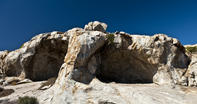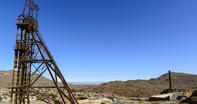Worthless Geological Formations
Unfortunately, Namaqualand is full of superficial traces of copper that look good on the surface but are not payable. There are also a number of worthless geological formations that look ‘green’, which were taken to be copper.

But the mania for speculation would brook no negativity and dozens of consortiums were quickly formed to take out leases on mining centres, once news had been of a shipment of copper arriving in Cape Town. In many cases, these were selected by people who had never set foot in Namaqualand.
There was also a hot market for the re-selling of leases, and those who were quick off the mark were able to turn a handsome profit by selling their centres to other companies. As the copper boom increased in intensity, there were some cautionary voices who warned that the bubble was going to burst, just as it had done on the Australian and Californian goldfields just a few years before.
Rumours of deep-pocketed British investors who were about to step in to buy out the South African leaseholders proved to be without foundation. Transportation remained a problem and several ‘mines’ had large quantities of ore lying around, with no way to convey it to market.
Other companies sent up mine managers with no idea about geology, who often dug up tons of ore that were found to contain not a trace of copper. To add to the confusion, native guides were hired at great cost to lead people to likely copper centres, which usually contained no mineral deposits whatsoever.
Orange River Transports Ore
But it didn’t matter. Copper Fever had gripped the Cape. Even the defunct South African Mining Company was resurrected and proceeded to revive operations at its old mine. This, perhaps, accounts for the story of Patrick Fletcher who is said to have been the first person to transport bags of ore from the old Gannakouriep mine down the Orange in a flat-bottomed boat called the Enterprise, in 1854.
Apparently, this practice continued until 1857, and some say that the mine remained in sporadic service until the 1920s. Fletcher, by the way, went on to have a long history in Namaqualand and his name crops several times as part of the area's history. Despite the limited success of these various mining ventures, very few companies managed to return any dividends to their shareholders and, after a few months, the boom started to lose steam.
Then, someone announced that they had discovered gold in Namaqualand and, shares soared again, despite the totally bogus nature of the claim (although it is true that Namaqualand copper does contain traces of gold, silver and other valuable minerals).
Height of the Madness

By now, the sceptics were growing more vociferous. Newspaper editorials poked fun at the gullible public. Parody prospectuses were published for the ‘Ladies Mining Company’ (its solicitors were listed as ‘Mesdames Fleece’em and Do’em) and the ‘Lunar Mining Company’ (which promised to pull the moon down to Earth so that copper could be scraped off the surface).
But it was to no avail. More and more people headed north to dig in, heavy mining machinery was lugged over the dry plains and lots of land was taken over by the voracious mining companies. At the height of the madness, applications for over 2000 centres were made, although only 200 of these were paid for, and it is estimated that between £70 000 and £100 000 was tied up in shares, mostly from small-time investors.
Unlike many other mining dilettantes, Von Schlicht knew what he was doing and his Consortium, the Namaqua Mining Company was quick off the mark to purchase a very promising site at Tweefontein (Concordia). Ironically, the Namaqua Mining Company’s cautious and realistic prospectus did not find favour with public investors eager for a quick profit and it struggled to get off the ground, eventually relying on a few private individuals for funding. Meanwhile, Phillips and King (which was also a privately-held company) made several wise purchases to add to their portfolio. The other companies, however, didn’t have a clue and were soon facing bankruptcy.
The Boom was Over
By early 1855, it was clear that the situation was untenable. After two years, the dozens of mining companies in Namaqualand had only exported 44 tons of ore (with two companies alone accounting for 33 tons). Hundreds of leases were forfeited through lack of payment and proposals were made to amalgamate all the copper mines into a single entity in order to manage the process more effectively.
Then, the government abruptly declared that it would grant no more new leases. The boom was over. By 1857, just three companies remained in operation.
These were Von Schlicht’s Namaqua Mining Company, the Phillips and King group and the South African Mining Company, which closed soon afterwards. While a few unscrupulous businessmen had made a killing by pocketing the money raised through share offerings, many investors were ruined and limped off into the taverns of Cape Town to lick their financial wounds.
By David Fleminger